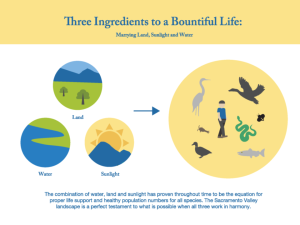By David Guy
Many of the leading scientists in California gathered in mid-October for a symposium to explore floodplains and to build a joint understanding around the state of floodplain science in the context of the salmonid life-cycle.
 As a life-long student of the Sacramento Valley and an active participant in efforts to improve fish and wildlife and water management in the region, I vividly recall seeing the early presentations by Ted Sommer, Dale Hall and others, as well as reading Floodplains: Processes and Management for Ecosystem Services. This work inspired me and it has sparked a new generation of leaders in the Sacramento Valley to learn more about the region and opportunities to improve fish and wildlife by reactivating our floodplains through innovative water management. The symposium motivated further thinking around our floodplains and it revealed tremendous promise to scale-up these efforts throughout the region.
As a life-long student of the Sacramento Valley and an active participant in efforts to improve fish and wildlife and water management in the region, I vividly recall seeing the early presentations by Ted Sommer, Dale Hall and others, as well as reading Floodplains: Processes and Management for Ecosystem Services. This work inspired me and it has sparked a new generation of leaders in the Sacramento Valley to learn more about the region and opportunities to improve fish and wildlife by reactivating our floodplains through innovative water management. The symposium motivated further thinking around our floodplains and it revealed tremendous promise to scale-up these efforts throughout the region.
We have seen several successful programs for fish and wildlife in the Sacramento Valley, with the emerging science around floodplains showing us why these programs have been successful and helping us learn from and point positive as new programs and projects are emerging. Waterfowl in the Sacramento Valley have benefitted from the combination of ricelands, refuges and other managed wetlands, which provide nourishment and a resting spot for birds in their journey along the Pacific Flyway. Spring-run salmon in Butte Creek have also benefitted by the connected floodplains in the Butte Sink and Sutter Bypass that provide food and safe haven for fish, working in tandem with the migratory pathways and spawning areas in the upper creek. Spreading water out and slowing it down across the historic floodplain combines sun, land and water in a way that brings the region to life. These success stories, and learning from the scientists who have studied these areas, provide both the foundation and the inspiration to more actively pursue projects and programs to reactivate the floodplain in the Sacramento Valley.

In this spirit, I truly appreciate the Sacramento River Science Partnership (SRSP) hosting the virtual Floodplain Science and Management Symposium, with a focus on the Sacramento Valley. It was great to see the discourse among decision-makers, managers, and scientists from across state and federal resource agencies, academic institutions, conservation organizations, water suppliers and landowners.
I also have the pleasure and am very fortunate to learn from and join forces with an amazing team organized as the Floodplain Forward Coalition, which is a very creative, multi-disciplinary, and hard-working group re-imagining the Sacramento Valley. This group learns from each other and is collectively scaling up the work on the floodplains with various efforts in the bypasses, on farm-fields and within the rivers to follow and better understand the science and help reactivate our floodplains for the benefit of fish and wildlife in harmony with farming in the region. I have also learned much along the way in this arena from my colleague Todd Manley, who has devoted his career to improving fish and wildlife in the Sacramento Valley in harmony with our farms and rural communities.
For anyone interested in science and the floodplains, I encourage you to check out the symposium, with the recordings of all three days available on YouTube:
- Day 1: Wednesday, October 13, 9am-3:45pm
- Day 2: Thursday, October 14, 9am-3:45pm
- Day 3: Friday, October 15, 9am-12pm
More information is also available on the Sacramento River Science Partnership’s events page.



